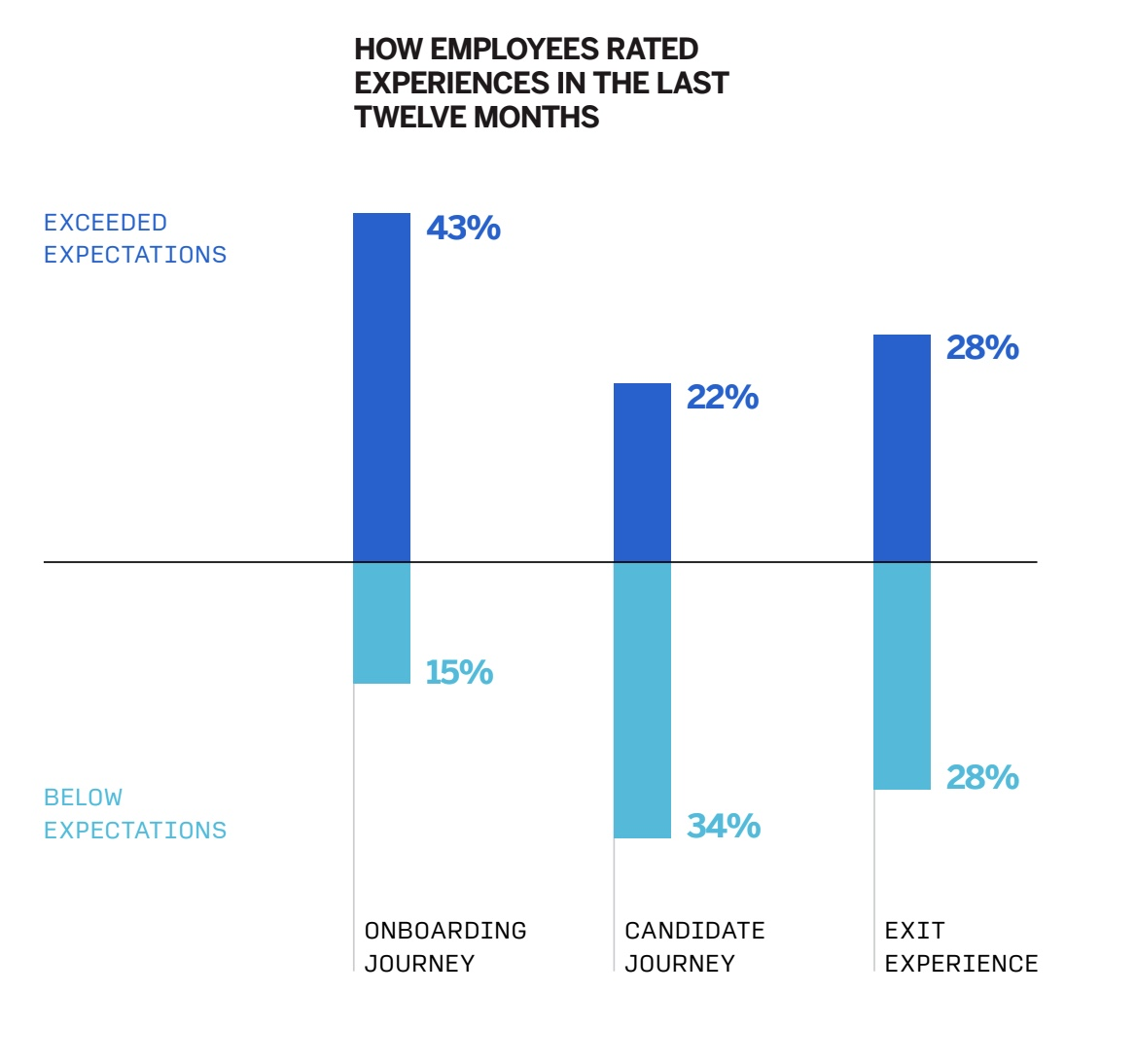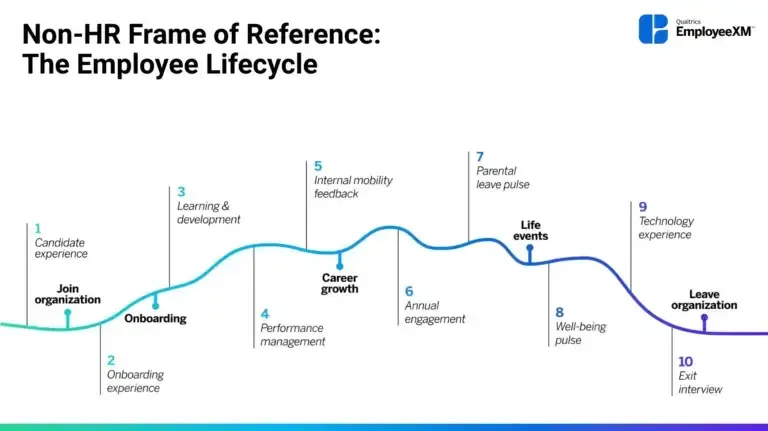A departing employee has handed in their notice. Maybe they felt that this wasn’t the right company for them. Maybe they got a new job offer. Maybe they decided their time with the company had simply run its course, or they fancied a career change. Maybe you could have helped keep them longer at the company? Who knows?
You should know. Pinpointing why people leave is crucial to your company’s success. People exit organizations every day: it’s called employee turnover and is part of every employee’s lifecycle.
But where it is ‘unwanted attrition’ – the loss of high-performing employees in critical roles for reasons that could have been prevented – it’s an urgent business issue.
High employee turnover affects a company’s bottom line: The average cost of replacing an employee is in excess of $4,700, with executive roles often exceeding $28,000, and high-demand roles costing $6K to $12K+.
Losing high-performing and engaged team members can affect other employees, your brand value, and your ability to deliver high-quality service and products.
Institutional knowledge and experience goes out of the door with exiting employees, and there may be extra pressure on other team members who are trying to cope with lower headcount.
Free eBook: Employee Lifecycle Feedback
Offboarding process vs. the exit interview process
An employee exit process, also known as ‘offboarding’, consists of several stages: the resignation, paperwork and documentation, communication to remaining employees, knowledge transfer, revocation of IT access and security, final payments and benefits, binding agreements, and, finally, what has been traditionally known as the exit interview.
Organizations are increasingly using automated employee exit surveys to gather more honest feedback from their departing workers rather than exclusively face-to-face interviews (although these are still used).
In this article we’ll be using the term, ‘exit interview’ to explore that final stage of an employee’s departure, even though it may include:
- Exit surveys
- Exit interviews
- Social exit surveys
We recommend a combined approach of all the above to get the very best feedback out of your exiting employees.
What is an exit survey?
An exit survey, taken at the end of an employee’s time with you, is the best way to find out why people leave your organization. You can identify trends, learn from them, and take action to reduce attrition, such as more robust hiring strategies for new employees, or improvements to your company culture, working practices, and management styles.
Exit surveys gather honest feedback and understand the reasons behind an employee’s departure. It’s a chance to learn from leavers’ experiences – the good and the bad.
Sometimes, exit surveys are supplemented with one-on-one interviews with selected leavers, such as executives, to fill any experience gaps in the survey, or to glean information in a way that only a formal chat can. You don’t have to interview everyone.
Pros and cons of an exit survey
The pros
Surveys are:
- accessible, scalable, and easy to distribute
- consistent, making analysis of trends easy
- confidential and anonymous, allowing honest feedback
The cons
- They may lack nuance, not capturing the same depth of information as an interview
- Responses may be misinterpreted
- They may be avoided, ignored or not completed
What is an exit interview?
Most companies conduct exit interviews. These are qualitative one-on-one interviews with selected departing employees, especially regretted leavers, to gather honest feedback and understand the reasons why they are leaving the company.
An exit interview formally closes the employee/employer relationship in a personable, constructive and helpful way.
Pros and cons of exit interviews
The pros:
- The conversation can be guided, allowing for more in-depth discussion to ask clarifying questions as needed
- Body language and other in-person clues add information
- They foster a more personal connection, leading to more open communication, and opportunity to turn departing employees into future advocates
- They send a signal to all employees that their views matter
The cons
- They depend on the honesty and candor of the exiting employee
- Exiting employees may be tempted to ‘sugarcoat’ things to give a good last impression, hoping for a positive future reference
- Interviews don’t allow much time to reflect before answering
- No anonymity
- Potential for bias
- Time consuming
What is a social exit survey?
A social exit survey uses 360 feedback, which surveys the departing employee’s peers, team members, direct reports, managers and other stakeholders. Because a social exit survey gathers information from different professional relationships, it builds up a broader, more objective picture of why the employee is choosing to leave.
You really don’t have to choose between employee exit interviews, exit surveys, and social exit surveys - you can use all three to cover every base and give you the information you need to understand why employees are leaving, and manage your talent.
Why have an exit interview process?
1. To identify organizational issues or areas that need improving
An employee departing is a rich source of data that can help pinpoint systemic problems within an organization. When combined with analysis from multiple employee exits, recurring themes will emerge, such as lack of career development opportunities, poor communication, and ineffective or chaotic management practices. When you see the patterns emerging, you’ll be able to take targeted action to improve shortcomings, preventing further attrition for the same reasons and enhancing your whole workforce’s experience.
2. To find out what causes unwanted attrition
Unwanted attrition generally results from:
- lack of development
- poor onboarding
- employees not feeling valued
- underwhelming pay and benefits, especially in the current high inflation
- poor management practices
- employee job dissatisfaction
- work life balance
- Occasionally, conflict with a co-worker or manager
These are all things that can build up over time, and the trigger to leave can happen at any stage in the employee lifecycle - from new hires to senior management.
The key to reducing unwanted attrition is to understand:
- why it happens
- what you can do to prevent the same things from happening to other high-performing employees
A good exit interview process will provide you with this information.
3. To preserve your organization’s brand and reputation
In 2024, our EX Trends Report highlighted how employee onboarding processes were being neglected and needed improvement.
Then, in our 2025 EX Trends Report, when we asked employees about their experiences over the last 12 months, we discovered that exit and candidate processes are even worse than onboarding.
This is important to rectify because entry and exit experiences strongly influence the relationship between the organization and its employees and customers.
First and last impressions count. Positive experiences often lead to employees being advocates even after they have left, while negative experiences can tarnish a brand’s reputation and recruitment potential for future employees.
When you don’t gather information from your outgoing employees, you miss out on vital data that reveals the reasons why people leave, and even alienate potential brand ambassadors.

This is important to rectify because entry and exit experiences strongly influence the relationship between the organization and its employees and customers.
First and last impressions count. Positive experiences often lead to employees being advocates even after they have left, while negative experiences can tarnish a brand’s reputation and recruitment potential for future employees.
When you don’t gather information from your outgoing employees, you miss out on vital data that reveals the reasons why people leave, and even alienate potential brand ambassadors.
4. To improve current and future employees’ experience
A well-managed, structured exit interview process that respects, listens to, and values exiting employees not only leaves them with a positive final impression, it also reassures the remaining employees that they will be treated with the same courtesy. This will boost morale, create a culture of fairness, and demonstrate that your organization is one that truly listens to its employees.
The importance of anonymity and confidentiality in the exit process
It’s essential that your exit surveys are anonymous and confidential so that they are a safe space for exiting employees to be honest and constructive in their feedback without fear of retaliation or damaging their relationship with the organization.
From your perspective, anonymous, confidential feedback is more valuable as it’s usually unfiltered, unbiased and more accurate. Employees who trust that their feedback is untraceable back to them tend to be more candid about their experiences with sensitive subjects such as their management, workplace culture, or systemic issues. The insights and patterns you gather will be more meaningful and accurate, helping you improve the overall employee experience.
Do’s and don’ts for a successful exit interview process
Here are some effective exit interview best practices:
Do:
- Make exit surveys and interviewing part of your HR policy so when an employee leaves, they expect it
- Plan and prepare for an exit interview – you can give the departing employee an exit survey first, following up if necessary with a one on one conversation
- Ensure full confidentiality for the departing employee
- Remind the employee of their obligations to keep confidentiality about the company
- Ask the same exit interview questions of everyone
- Ask open questions that require more detail than yes or no answers
- Focus only on the company, with a view to improving it and moving it forward
- Involve the employee’s direct manager
- Analyze the information collected in the interview and act on its findings
Don’t:
- Require every employee to have an exit interview – the process should be voluntary
- Try to persuade the employee to stay – the time of resignation was the opportunity for that
- Wait until the employee’s last day – they will be distracted and disengaged
- Ask about specific people or specific incidents
- Give your own opinions about individuals or incidents
- Allow the discussion to descend into office gossip
- Forget that a positive, effective exit interview can create a future company ambassador
Exit interview question themes
Research by Qualtrics into employee turnover has identified four key performance indicators (KPIs) that are important to measure through an exit survey:
1. Experience vs. expectations
“Overall, to what extent did your experience working at this company meet your expectations?”
2. Likelihood to recommend
“I would recommend this company to people I know as a great place to work.”
3. Organizational belonging
“I felt a sense of belonging at this company.”
4. Likelihood to rejoin
“I would consider rejoining this company.”
These allow an organization to understand how much the person leaving:
- has had a positive experience and positive perception
- Is exiting as an advocate or a critic
Qualtrics also identifies six dimensions, or topics, that drive a positive employee experience:
1. Development
Growth is a fundamental human need. Seeking further development opportunities is still emerging as a top driver for finding alternative employment.
It’s measured with: meaningful career development discussions, regular conversations about performance, and giving opportunities to improve skills
2. Enablement
This is having the ability to get work done. When employees, especially for high performers, don’t feel enabled, this can be a great source of frustration. You need to understand if employees had the right resources and physical work environment they needed to be productive.
It’s measured by looking at how: the job makes good use of skills and abilities, the processes support productivity, managers help to remove barriers, and workspace and technology supports productivity.
3. Reward
Receiving fair pay and recognition for individual contributions at work is the backbone of the employee and employer relationship. When these don’t align, they can compound other perceived issues in the employment relationship.
It’s measured by looking at fair pay, benefits that meet employee needs, and meaningful recognition.
4. Support
Employees must be valued, respected and not overloaded with work. Today’s workforce increasingly seeks job opportunities where they have the flexibility to manage their workload alongside their personal life.They also seek out work environments where there are high levels of respect and trust.
Support is measured by: trusting relationships, managers treating teams with respect, the amount of support to adapt to organizational changes, and how much managers care about well-being.
5. Values
Our 2023 Employee Experience Trends Report found that being employed isn’t just about having a job – it’s a part of a person’s value system.
When employees feel that their organization embodies these values, they’re 27% more likely to have higher engagement scores, and 23% more likely to stay working for more than 3 years.
Departing employees are actually leaving a culture that’s not a good fit for them. Many employees choose to work for organizations whose culture aligns with their own personal values.
Measure values with: open and honest communication, pride in the company’s impact on the world, and checking whether management behavior is consistent with company values.
6. Workload
It’s essential people can balance work tasks with their personal needs. It’s no longer enough to engage employees and encourage them to work hard. Even engaged employees who don’t feel they have a good work life balance are unlikely to see a long-term future with the organization.
Measure whether workload is manageable and flexible enough to meet work and personal needs.
This model is complemented with questions that ask the employees their reasons for leaving, plus a free-text question to understand what (if anything) could have been done to keep them. There are also demographic questions to help understand the differences in employee experiences across different segments of the organization.
Integrating exit interview feedback into the employee lifecycle
Exit interview feedback isn’t standalone. It’s the final stage in the employee lifecycle:

When your human resources department combines exit interview feedback with data from onboarding, engagement, training and development, and other surveys and employee listening, you’ll get a holistic, unified view of what worked, and didn’t work, for that particular employee. Scale it up and you’ll be able to spot patterns in the data analysis, such as poor onboarding experiences leading to higher turnover. You can then focus your efforts on improving areas of weakness.
Automate your exit interview feedback with Qualtrics
When you use the exit solution on Qualtrics XM, you’ll understand why your top performers leave, and inform actions across your whole organization to reduce unwanted attrition. With real-time employee exit interview insights, you’ll have the data you need to retain top talent and build a happier, more engaged workforce who will need less offboarding.
You’ll be able to:
- Automate your exit interview feedback with integrations into your HRIS system, to capture open, honest employee feedback so your HR team can focus on turning exit feedback into improvements
- Embrace the power of AI and intelligent analytics and step in early to prevent employee departure
- Make connections between feedback at different stages along the employee lifecycle and understand when to intervene, so you can have the biggest impact on reducing attrition.
- Understand the impact of every interaction on the whole employee experience, with all your employee feedback on a single platform
- ‘Close the loop’ with analyzed feedback that you can share with leadership, by acting upon it to drive meaningful change and keep your great people



